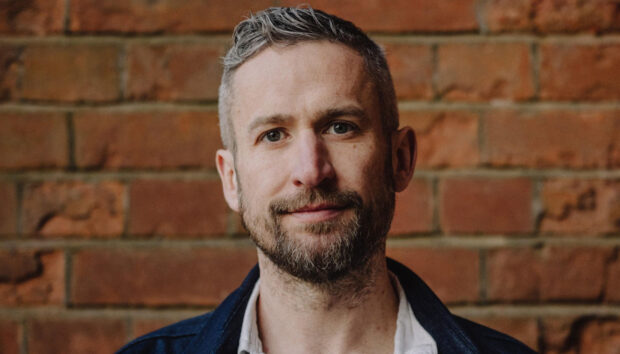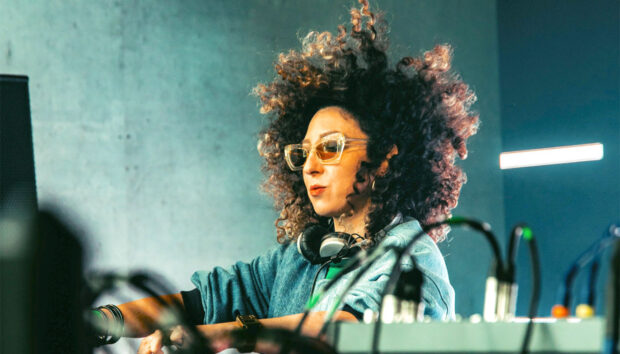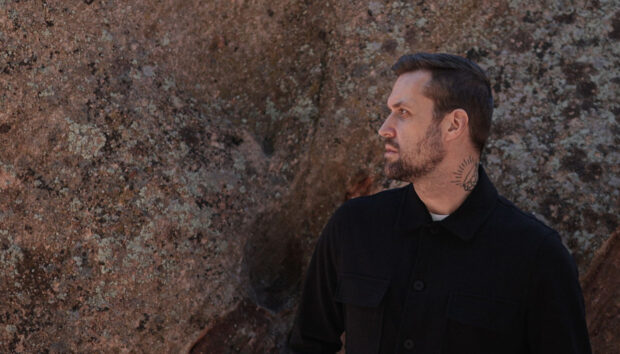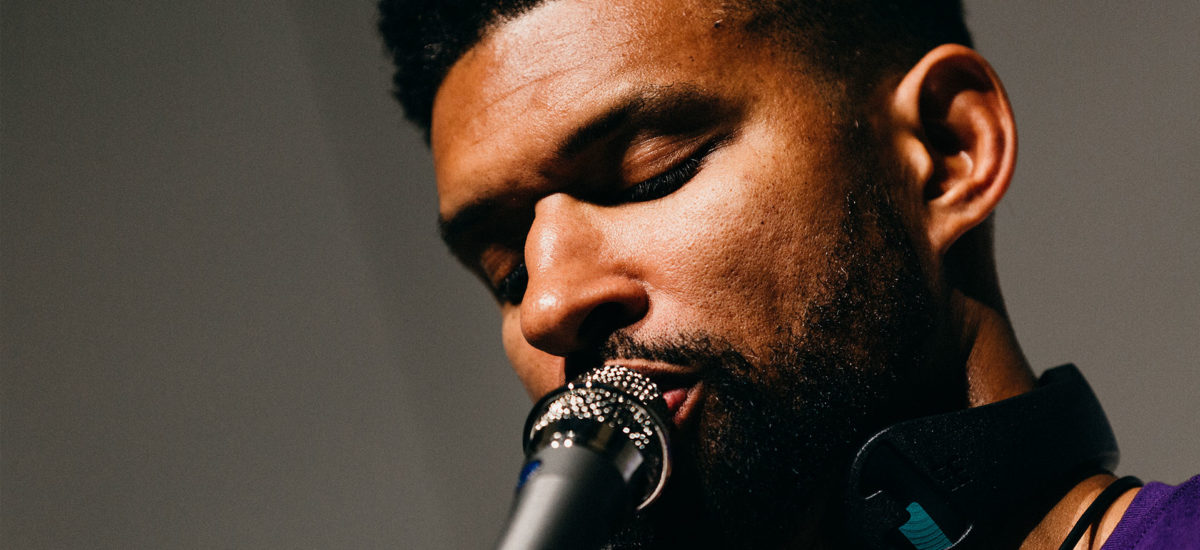
Responsible for revolutionizing the talkbox, Native Instruments spoke to Bosko and Maya Kante in Los Angeles about the origins of ElectroSpit, its application, and use on the new Sounds.com pack.
At the Native Instruments offices in Los Angeles, Bosko Kante greets people with the robotized sound of the ElectroSpit, the portable talkbox he’s spent the past four years developing with his wife, Maya. “Hello, how are you?” he sings in buzzy tones through the device, which wraps snugly around his neck.
For most of his career, Bosko’s been closely associated with the talkbox, an instrument you’ve heard many times whether you know it or not. That’s the talkbox’s warble on Peter Frampton’s “Do You Feel Like We Do” and Rufus and Chaka Khan’s “Tell Me Something Good.” It’s what gave Zapp more bounce to the ounce, and what inspired Dr. Dre to funk up “California Love” with a talkbox cameo by Zapp co-founder Roger Troutman. Last year, it featured prominently on two Grammy-winning singles, Bruno Mars’ “24K Magic” and Kendrick Lamar’s “Loyalty.” “And people don’t even realize it’s the talkbox!” says Maya. “They’ll confuse it with Auto-Tune.”
Unlike Auto-Tune, which electronically manipulates an existing vocal track, the talkbox gets its signal from a conventional instrument like guitar or keyboard, then runs that sound through a plastic tube. The performer inserts the tube into his mouth and uses his mouth and lips to shape the sound into words; no actual singing is required. It’s an ingenious invention but a cumbersome one, requiring a lot of outboard gear — including a separate speaker and amp — as well as vocal dexterity to operate.
With the ElectroSpit ESX-1 mobile talkbox, Bosko and Maya hope to make their favorite instrument more accessible to musicians of all skill levels. Bosko, who besides being a talkbox master also holds a degree in mechanical engineering from the University of Southern California, took the basic features and functionality of the talkbox and shrank them down to a device no bigger than a pair of headphones. It can be played with a smartphone app or connected to any synthesizer, electric guitar or virtual instrument plug-in. As Bosko says in the video for an upcoming Kickstarter campaign to fund the first production run of ESX-1’s, “You put it on and instantly, you’re funky.”
To celebrate the arrival of the ElectroSpit, Bosko and Maya teamed up with Native Instruments to create a sample pack of talkbox sounds for NI’s recently launched Sounds.com music sample subscription service. Ahead of that release, the couple told us more about the ElectroSpit’s origins, and how their sample pack can be used to give any track a little extra funk.
Check out Future Funk Talkbox Vocals by ElectroSpit here.
Bosko, how did you first get into the talkbox?
Bosko: Going way back, when I was a kid, I used to breakdance, and one of my favorite songs to breakdance to was “More Bounce to the Ounce.” I won a set of turntables in a breakdancing contest and started DJing; I used the money from DJing to buy some equipment and started producing. And always in the back of my head, that talkbox sound was one of the things that I really loved.
I didn’t learn how to actually play the talkbox until much later, when I got a record deal with Atlantic Records and I used part of the advance to buy a talkbox. And then from there, one of the big productions I used the talkbox on was this E-40 remix, “Sprinkle Me.”
Maya: It wasn’t until he started playing the talkbox that the doors got opened to much bigger artists like T.I. and Kanye West and J. Cole and Janelle Monae. The talkbox really took his career to the next level. It defined him as a producer.
You mentioned Kanye. I gather it was a performance with Kanye that gave you the original idea for trying to come up with a more portable version of the talkbox.
Bosko: Exactly. It was the American Music Awards. I was gonna perform “The New Workout Plan” with Kanye West and you know, the routine is real active. You’re moving around, and the talkbox is this big, clunky instrument that I love but you can’t move around with it. So it ended up, I just had to lip sync. I wanted to get up and freestyle and improvise with Kanye. But you know, I just couldn’t do it. And it got me thinking, “How can I fix this? How can I make something that will allow me to perform live?”
Some years later, we applied to this startup accelerator called Zoo Labs in Oakland that was started by some ex-Google engineers, Vinitha and David Watson.
What year was this?
Maya: 2014. The whole model for Zoo Labs is to take Silicon Valley startup techniques and help artists and bands apply those to their business practices. It was a two-week residency. You live there for two weeks, and at the end, you have to actually present a deck to a roomful of investors.
Bosko: One of the most important workshops that we did in the residency was this futures workshop, where you look at trends of what has happened in the past five to 10 years and extrapolate out another five or 10 years in the future. And one of the trends that we clearly saw was that the music studio has gone from being this huge room, with a huge mixing board, to a desktop computer, then to a laptop computer — and now, the power of the mobile phone is enough to create anything you wanna do.
Maya: That’s why we have the accompanying app with the ElectroSpit. We did an ethnography and we found that there are so many more people now who want to actively participate in music creation who have not had the benefit of expensive equipment or time for lessons. We want to enable everyone to create pro quality music.
You’re also competing in a way with things like Auto-Tune.
Bosko: The experience of playing the talkbox is totally different than the experience of using Auto-Tune. When you’re using Auto-Tune, it’s pitch-correcting your voice and you hear your own singing. With ElectroSpit you replace your vocal cords with an instrument and — especially if you have some talent or some practice with an instrument like keyboard or guitar, or you’re using an app like the ElectroSpit app that assists you in playing — it’s just really fun to have that sound come through your body, as opposed to hearing yourself sing off-key.
Maya: That’s the difference: Auto-Tune is pitch correction, whereas talkbox is an instrument. We always say the quickest way to piss off a talkboxer is to ask them how they did that Auto-Tune. [laughs]
You mentioned that you’ve developed an app for the ElectroSpit. How does it control the pitch? Is there a motion detection element to it?
Bosko: There are keys for the scale. And then just like on a traditional synthesizer, you can add vibrato with a pitch wheel. Or you can shake the phone which allows you to add vibrato or pitch bends via the accelerometer.
That was part of the Zoo Labs experience. I had to learn to program and develop iOS apps, with some assistance from the founder, David Watson. That was a really fun process. I also recently started working with another talented programmer named Charles Deck, who helped us add some features to the app.
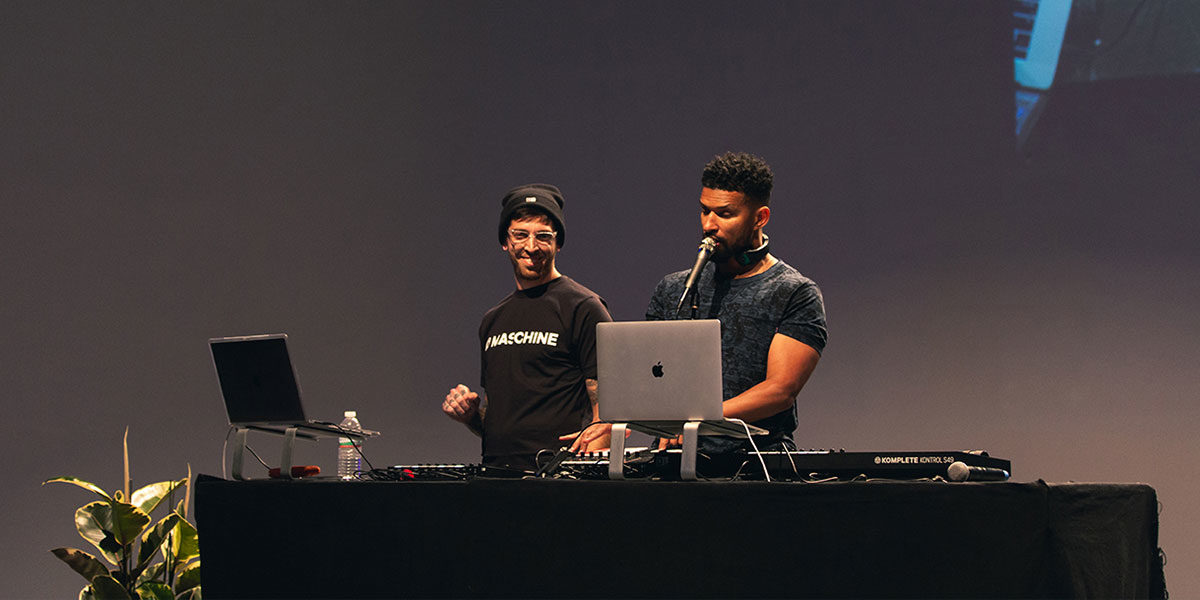
How does the ElectroSpit interface with Native Instruments products?
Maya: We just did a really cool video for our Sounds.com sound pack. We wanted to give examples of how the sound pack could be used.
Bosko: I originally recorded the sound pack using the Kontrol keyboard to control a custom sound that we created for ElectroSpit using the Massive synthesizer. And then, to do a live performance, we loaded the Massive sound into Maschine and put it into keyboard mode and created a major scale. It was really dope, because the Maschine has a built-in touch strip that you can use to do pitch bend or modulation. And once you set up your own scale on the pads in keyboard mode, you can move really fast and be really expressive.
So what’s the next phase for the ElectroSpit? You’re going to launching a Kickstarter soon, right?
Maya: We got some really dope artists in the Kickstarter video, like David Guetta and Teyana Taylor. And some of them are investors, like P-Thugg from Chromeo. The video that you see that’s part of our Kickstarter was that very first meeting and him seeing it. And he was just like, “This is crazy! Do you guys need money?” [laughs]
There are some pretty amazing people in the video using it. You’ve got Teddy Riley in there, and Terrace Martin, Chief Xcel.
Bosko: I grew up loving Teddy Riley and New Jack Swing. But I had never met him. He saw a post that Maya created on Instagram with Terrace Martin and he was like, “What is this? How does this work?”
Maya: We ended up flying out to Vegas and he was like, “Man, I need this for my album.” So as it got more momentum and we started getting more investors, we said, “Our next step has to be manufacturing this.” That’s the mission for the Kickstarter: to pay for the tooling and the manufacturing. Because those are the one-time costs.
Have you released any music using the ElectroSpit ESX-1 yet?
Bosko: The first record released featuring the ESX-1 was “Drum Machine” by, Big Boi of OutKast and Phantogram, and I just used it on David Guetta vs. Bruno Mars “Versace on the Floor.” I also did a duet with Teyana Taylor called “Control Me” coming out on her album in June.
Tell me more about what people can expect from the Sounds.com sample pack.
Bosko: We put some different stacked harmonies, where you have each note and instead of just playing it as one tone, I would play like a line or a riff expressively, and then harmonize that. So it gives you a lot of possibilities, whether you want to use the whole chord or each note. And then certain phrases that I thought would be interesting that you can chop up and rearrange however you want to do.
Maya: Some of them are classic West Coast funk phrases. And we checked out what was already on there and there doesn’t seem to be any harmonies or that many phrases that are done with the clear level of pronunciation that is possible with ElectroSpit. So it’s gonna be a pack that’s really unique to Sounds.
So this is kind of a way for people to have Bosko on the track without Bosko actually being in the room.
Maya: Yeah. Have a little Bosko essence on their track.
And for funk producers who want to get that authentic talkbox sound, which is almost impossible to get with Auto-Tune.
Maya: It’s not almost impossible; it is impossible.
Bosko: And I’ve tried. I’m not a technology hater, obviously. I love the sound of Auto-Tune, but it’s kind of like you have your acoustic guitar and you have your electric guitar.
Maya: They both have their place.
Check out the ElectroSpit Kickstarter page here.








